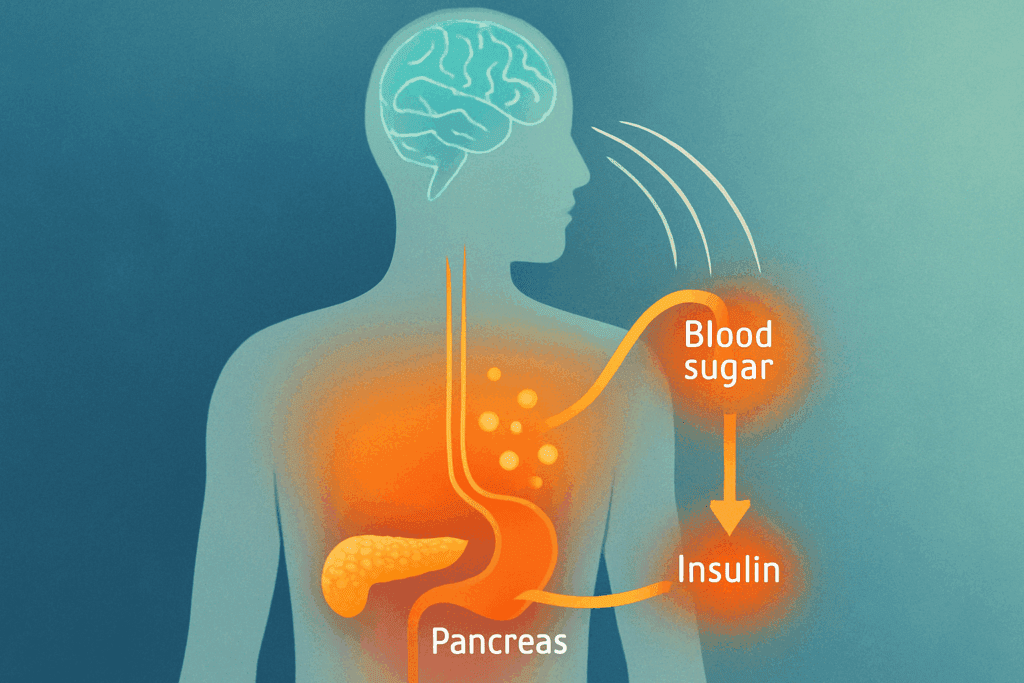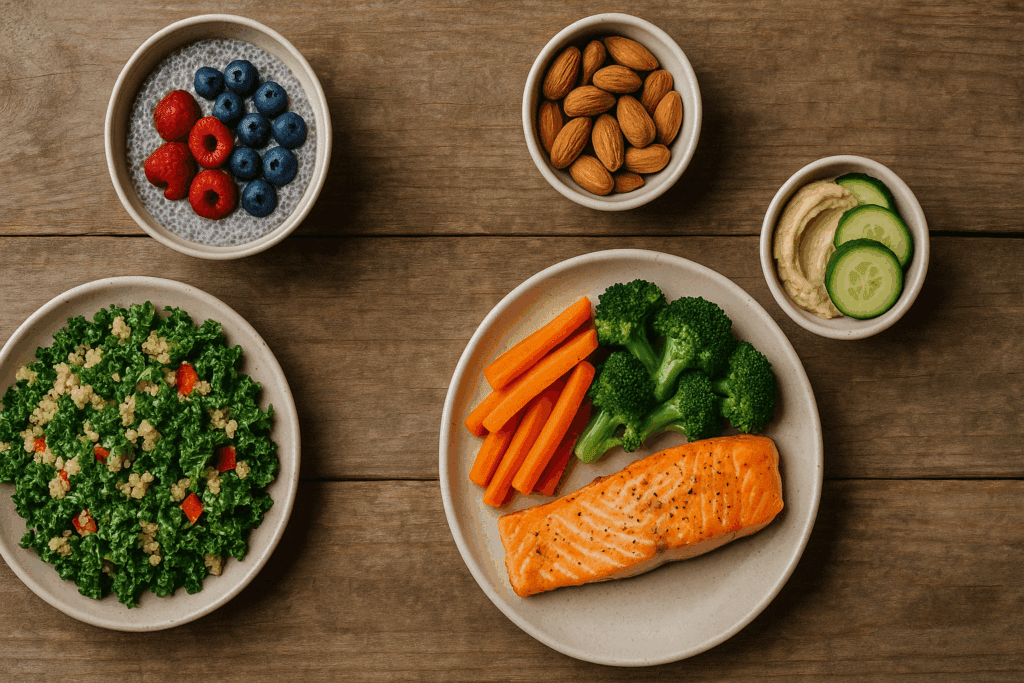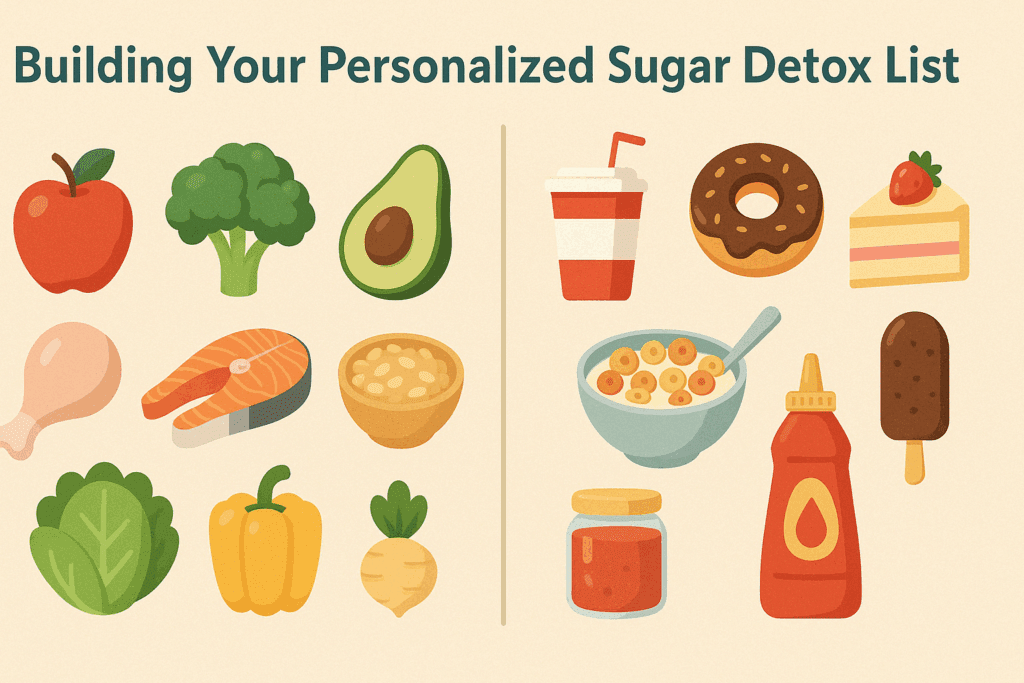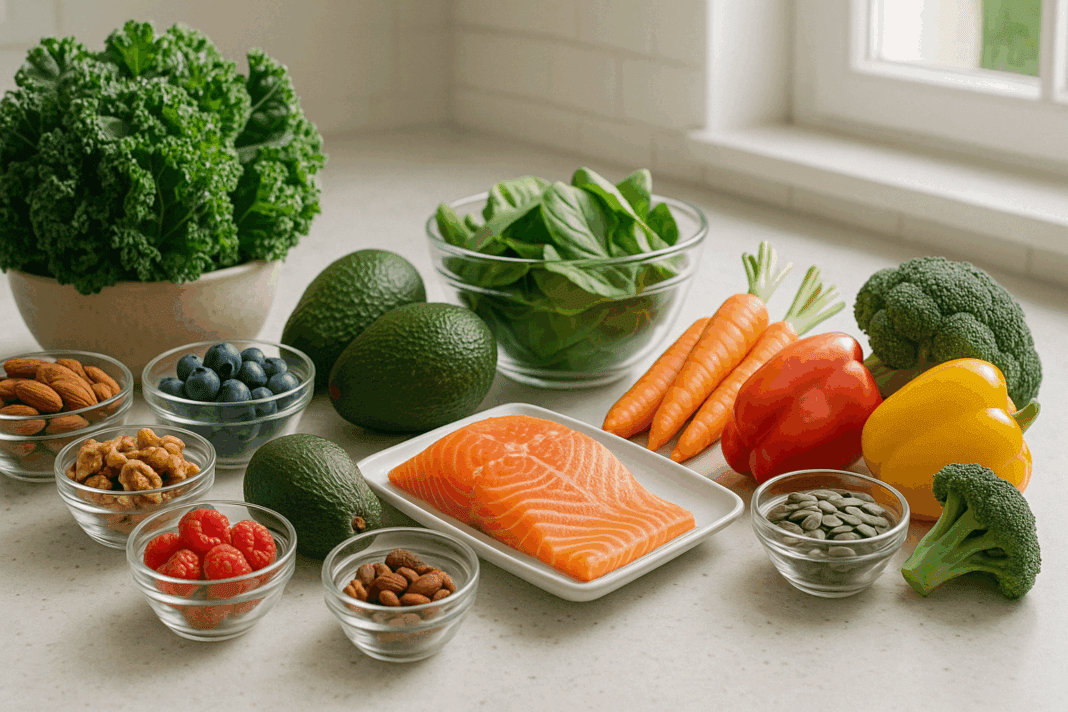Introduction: Why a Sugar Detox Plan Matters Now More Than Ever
In an era where sugar sneaks into everything from salad dressings to plant-based milks, the need for a sustainable, science-backed sugar detoxification diet has never been more urgent. High-sugar diets are increasingly linked to metabolic dysfunction, mood swings, inflammation, and chronic diseases like type 2 diabetes and heart disease. Yet cutting sugar cold turkey without a thoughtful strategy often leads to frustration and rebound cravings. That’s why creating a balanced and gradual sugar detox meal plan is essential—especially for beginners aiming to reclaim energy, stabilize mood, and support long-term health.
Understanding the fundamentals of a sugar detox for beginners means recognizing how refined sugars influence hormonal regulation, particularly insulin and leptin. These hormones not only control blood sugar levels but also hunger, fullness, and fat storage. The goal of a sugar detox isn’t to eliminate all sugars forever—it’s to reset the body’s sensitivity to natural sweetness while nurturing the gut, liver, and metabolic systems. Through a carefully crafted sugar detox diet, complete with a supportive sugar detox food list and realistic meal plan, individuals can begin a health transformation that’s rooted in evidence, not gimmicks.
This article explores how to build the best sugar detox for beginners with practical strategies, science-backed food choices, and expert tips to ease the transition. Whether your goal is weight loss, more stable energy, better skin, or simply to regain control over your eating habits, this guide is designed to provide both clarity and confidence in your journey.
You may also like: Why Am I Craving Sweets All of a Sudden? Expert-Backed Reasons and How to Stop Sugar Cravings Naturally

Understanding the Science Behind Sugar Detoxification
To make informed decisions during your sugar detox diet, it helps to understand the physiological mechanics behind sugar consumption and withdrawal. When we consume simple sugars—like glucose, fructose, and sucrose—they’re rapidly absorbed into the bloodstream, leading to a surge in blood sugar. This spike triggers the release of insulin from the pancreas, a hormone that shuttles sugar into cells for energy or storage.
Frequent sugar intake disrupts this finely tuned system, often resulting in insulin resistance, where cells stop responding effectively to insulin. This is a precursor to many chronic diseases, including type 2 diabetes. More subtly, high-sugar diets are associated with fatigue, mental fog, and anxiety due to fluctuations in blood glucose and stress hormone levels. When you initiate a sugar detoxification diet, your body begins to re-regulate these systems, gradually restoring hormonal balance.
Sugar detox plans work by reducing external sources of added sugar and processed carbohydrates while increasing nutrient-dense whole foods. This gives the body space to recalibrate. While the first few days of a sugar detox for beginners may involve withdrawal symptoms such as irritability or cravings, these typically subside as your blood sugar stabilizes. Understanding this process can help you mentally and physically prepare for the transition, ensuring long-term success rather than short-term restriction.

Crafting a Sugar Detox Meal Plan That Works in the Real World
A successful sugar detox meal plan must be sustainable, practical, and nutritionally complete. Rather than focusing solely on what to eliminate, the best sugar detox plans prioritize what to add—fiber-rich vegetables, healthy fats, clean proteins, and naturally sweet whole foods like berries or sweet potatoes. These choices help blunt blood sugar spikes and reduce cravings by supporting satiety and gut health.
For breakfast, consider a chia seed pudding made with unsweetened almond milk and topped with fresh blueberries. This meal is low in added sugars yet rich in omega-3s, fiber, and antioxidants. Lunch could include a kale and quinoa salad with avocado, chickpeas, and lemon-tahini dressing. For dinner, a balanced plate might feature roasted salmon or tofu with sautéed greens and cauliflower mash. Each of these meals aligns with a sugar detox diet by excluding refined carbs and incorporating satisfying textures and flavors.
Snacks are often where sugar sneaks in, so a well-designed sugar detox meal plan should include clean snack options. Raw nuts, hummus with sliced cucumbers, or a small apple with almond butter can curb hunger without compromising your progress. By focusing on variety and satisfaction, your sugar detox for beginners becomes a nourishing lifestyle shift rather than a rigid, short-term challenge.

Building Your Personalized Sugar Detox Food List
One of the most empowering steps you can take during your sugar detox journey is creating a sugar detox food list tailored to your preferences, cultural habits, and health goals. While many online guides offer generic suggestions, personalization increases adherence and enjoyment. Start by identifying common sources of hidden sugars in your current diet—think ketchup, breakfast cereals, protein bars, and flavored yogurts. These should be replaced with no-sugar or low-sugar alternatives that still satisfy your taste buds.
The core of your sugar detox foods should include non-starchy vegetables (like spinach, zucchini, and broccoli), high-fiber fruits (such as raspberries and green apples), quality proteins (lentils, tempeh, eggs, or wild-caught fish), and healthy fats (avocados, nuts, and olive oil). Whole grains like quinoa and steel-cut oats are generally acceptable in moderation, particularly for those not on strict low-carb plans. The best sugar detox food list is built on whole, minimally processed ingredients that nourish and stabilize.
Equally important is knowing what not to include. During your sugar detox diet, avoid sugary drinks, processed snacks, white bread, and sauces or dressings with added sweeteners. Read nutrition labels carefully—even products marketed as “healthy” can contain hidden sugars under names like maltodextrin, agave nectar, and brown rice syrup. Staying informed helps you make smarter choices and avoid the common pitfalls that undermine many sugar detox plans.

Navigating Sugar Cravings with Expert-Backed Strategies
Cravings are a natural part of the sugar detoxification process, particularly in the first week. These urges are not a sign of failure but a normal response to dopamine and serotonin shifts in the brain. Fortunately, several expert-approved strategies can help you ride the wave of withdrawal without caving to temptation.
First, hydration is key. Sometimes thirst is mistaken for hunger, and drinking water—especially infused with lemon or cucumber—can reduce cravings and support detoxification. Herbal teas like peppermint, cinnamon, or licorice root offer natural sweetness without sugar and have calming effects on the digestive system and nervous system. Incorporating these teas into your daily routine can be a game-changer during the sugar detox diet.
Another proven strategy is using the “crowding out” method. Instead of focusing on restriction, fill your plate with nutrient-dense foods so there’s little room (or need) for sugar. A hearty lentil and vegetable stew, for example, can leave you feeling so full and satisfied that dessert loses its appeal. Mindful eating also plays a powerful role—by slowing down, chewing thoroughly, and savoring flavors, you reconnect with hunger cues and satisfaction signals that are often dulled by a high-sugar diet.
Sleep is another overlooked component of sugar cravings. Sleep deprivation raises ghrelin (the hunger hormone) and lowers leptin (the satiety hormone), leading to increased appetite for sugary, high-carb foods. Aim for at least 7 to 8 hours of quality sleep per night to optimize your hormone balance and improve your odds of sticking to your sugar detox plan.

Sugar Detox for Beginners: What to Expect in the First Two Weeks
The first few days of a sugar detox for beginners are often the most challenging. It’s common to experience symptoms like fatigue, mood swings, headaches, or even flu-like sensations—sometimes referred to as the “sugar flu.” These reactions occur as your body adjusts to a lower glycemic environment and begins to rely more on fat for fuel. This adaptation period typically lasts 3 to 5 days, after which energy levels stabilize, mental clarity improves, and cravings diminish significantly.
Week two is where most people begin to feel the real benefits of their sugar detox plan. Many report waking up with more energy, experiencing fewer energy crashes in the afternoon, and noticing improvements in digestion, skin clarity, and even joint discomfort. These changes are partly due to reduced systemic inflammation and improved insulin sensitivity, two of the main goals of any sugar detoxification diet.
To support your success during this critical transition, it’s helpful to set up structure and support. Meal prepping on weekends can prevent the temptation of fast food or processed snacks when you’re tired or busy. Sharing your goals with friends or family—or even joining an online sugar detox support group—can keep you accountable and motivated. When the sugar detox plan is treated as a journey rather than a punishment, it becomes a foundation for lifelong vitality.

The Best Sugar Detox: Lifestyle Shifts That Stick
The best sugar detox is one that goes beyond meal planning and food lists to inspire a lasting shift in your mindset and habits. This means developing a more intuitive relationship with food—one that prioritizes nourishment, sustainability, and enjoyment over extremes or guilt. Instead of thinking of sugar detox as something you “complete,” think of it as a reset that informs your choices moving forward.
This lifestyle approach includes redefining your relationship with sweetness. Many people find that after completing a sugar detox plan, their taste buds become more sensitive, allowing them to enjoy the natural sweetness of fruits, roasted vegetables, and even nuts in a way they didn’t before. This recalibration is one of the most powerful outcomes of a sugar detox diet—it helps you reclaim pleasure in real food and reduces reliance on artificial gratification.
Ongoing practices like mindful eating, stress reduction, regular movement, and cooking at home reinforce the progress made during the initial detox period. These habits don’t just help you avoid sugar—they help you thrive. The goal isn’t perfection but progress: using what you’ve learned to make choices that align with your health values and energy needs day by day.

Frequently Asked Questions About Sugar Detox Meal Plans and Healthy Lifestyle Transitions
1. How can a sugar detoxification diet influence long-term metabolic health beyond just weight loss?
A sugar detoxification diet doesn’t only support short-term goals like trimming excess weight or curbing cravings—it can also recalibrate your metabolic set point. By eliminating processed sugars, the body gradually becomes more efficient at using stored fat for fuel, improving metabolic flexibility. This shift is crucial for preventing insulin resistance and stabilizing blood sugar over the long haul. Many people don’t realize that sustained metabolic health supports hormonal balance, better stress response, and reduced risk of inflammatory conditions. When a sugar detox diet is consistently followed, it primes the body to operate on a more even energy keel, resulting in better stamina, mental focus, and appetite regulation—outcomes that far outlast the detox itself.
2. Is it possible to follow a sugar detox plan while adhering to a vegetarian or vegan diet?
Absolutely, and in fact, plant-based eating can complement a sugar detox plan beautifully. Many of the most effective sugar detox foods—like legumes, cruciferous vegetables, avocados, seeds, and whole grains—are staples in vegetarian and vegan diets. The key is to avoid relying on meat substitutes or dairy alternatives that contain hidden sugars, such as sweetened soy milk or processed vegan cheeses. A plant-forward sugar detox meal plan should emphasize naturally fiber-rich, unprocessed options to maintain satiety and support blood glucose stability. Including fermented foods like kimchi or unsweetened yogurt alternatives can also nurture the gut microbiome, which plays an underappreciated role in sugar cravings and overall detox success.
3. How can I transition from a sugar detox for beginners into a long-term maintenance routine?
Once the initial sugar detox for beginners is complete, transitioning into a sustainable lifestyle requires intentional planning. It helps to reintroduce complex carbohydrates slowly while still avoiding added sugars and highly refined products. Instead of reverting to old habits, expand your sugar detox food list with new whole-food staples that satisfy your palate without triggering cravings. For instance, roasted root vegetables can serve as naturally sweet comfort foods, and cacao nibs can replace sugary chocolate in snacks. The best sugar detox strategies are those that evolve, becoming less about strict elimination and more about mindful inclusion of nutrient-dense foods that support energy, immunity, and digestion.
4. What role does the gut microbiome play in sugar detox success or failure?
Emerging research suggests that the gut microbiome is deeply involved in sugar metabolism and even sugar cravings. When someone follows a sugar detoxification diet, they’re not just retraining their taste buds—they’re shifting the population of gut bacteria that thrive on simple sugars. A successful sugar detox meal plan supports this microbial rebalance by feeding beneficial bacteria with prebiotic fibers found in foods like asparagus, garlic, leeks, and oats. Without this support, harmful bacteria may continue to fuel sugar cravings, undermining your progress. Therefore, including gut-supportive sugar detox foods is essential for both short-term withdrawal ease and long-term craving reduction.
5. How does emotional eating impact sugar detox efforts, and how can it be addressed?
Emotional eating is often the hidden challenge behind failed sugar detox attempts. Stress, boredom, or sadness can all increase the desire for sugary foods, which stimulate the brain’s reward centers and provide temporary relief. A well-structured sugar detox plan should include emotional coping tools—such as journaling, breathwork, or professional therapy—to help reframe the emotional connection with food. Some individuals find success by keeping a “trigger tracker,” where they log cravings, mood, and context, eventually identifying patterns. This emotional awareness, combined with a reliable sugar detox meal plan, strengthens long-term behavior change and breaks the addictive cycle more effectively than food restriction alone.
6. What’s the difference between a low-carb diet and a sugar detox diet, and can they be combined?
While both approaches aim to control blood sugar, a sugar detox diet specifically targets added sugars and highly processed carbohydrates, rather than all carbs indiscriminately. A sugar detox for beginners focuses on natural, whole-food carbohydrates like legumes, vegetables, and select fruits, which support energy and gut health. Low-carb diets, by contrast, often restrict even these complex carbs, which may not be suitable—or necessary—for everyone. That said, the two approaches can complement each other if tailored thoughtfully. For example, a sugar detox meal plan can be made lower in carbs by prioritizing non-starchy vegetables and healthy fats, particularly for those managing insulin sensitivity or metabolic syndrome.
7. Are there any emerging trends or innovations in the best sugar detox strategies today?
One exciting trend in sugar detoxification is the use of continuous glucose monitors (CGMs) to personalize detox efforts. These devices offer real-time feedback on how different sugar detox foods affect your blood sugar levels, allowing you to fine-tune your sugar detox plan with precision. Another development involves functional foods, like teas infused with cinnamon, berberine, or bitter melon, which may support glycemic balance naturally. Some companies now offer AI-driven apps that generate adaptive sugar detox meal plans based on individual data, improving adherence and results. These innovations represent a shift from one-size-fits-all strategies toward data-informed detox approaches that align with the principles of precision nutrition.
8. How can families implement a sugar detox plan without alienating children or picky eaters?
Making a sugar detox plan work for the entire family requires creativity and compromise. Rather than labeling foods as “bad,” focus on positive language around the benefits of energy, mood, and strong bodies. Involving children in shopping and cooking with sugar detox foods—like sweet potatoes, apples, or natural nut butters—builds ownership and curiosity. You can adapt the sugar detox food list to include family-friendly swaps like banana-based ice cream, homemade trail mix, or smoothies with unsweetened cocoa and avocado. When the focus is on fun and flavor, not restriction, families are more likely to adopt the best sugar detox habits together.
9. What are some overlooked signs that your sugar detox is working, even if the scale doesn’t budge?
Success on a sugar detox plan isn’t always measured in pounds. One early yet often overlooked sign is improved sleep quality—people often report falling asleep more easily and waking with fewer energy crashes. Another subtle sign is reduced joint stiffness or bloating, indicating a decrease in systemic inflammation. Better skin clarity and less frequent mood swings also reflect internal hormonal rebalancing. Even if your weight doesn’t shift immediately, these improvements suggest that your sugar detoxification diet is activating deep physiological healing processes that go far beyond cosmetic results.
10. Can a sugar detox meal plan support mental clarity and cognitive performance?
Yes, and the effect can be surprisingly profound. Excess sugar is known to impair memory, concentration, and emotional regulation by contributing to neuroinflammation and glycemic swings that affect the brain. A nutrient-dense sugar detox meal plan stabilizes glucose availability to the brain, which thrives on steady energy—not spikes and crashes. Many people report improved focus, reduced anxiety, and a “lifted brain fog” within 7 to 10 days of beginning a sugar detox for beginners. Additionally, incorporating brain-boosting sugar detox foods—like walnuts, blueberries, and leafy greens—further enhances cognitive resilience, making detox an investment not just in your body, but your mind as well.
Conclusion: Embracing a Healthier Future with a Sustainable Sugar Detox Plan
Committing to a sugar detox meal plan isn’t just about cutting out sweets—it’s a declaration of self-care, resilience, and clarity. For beginners, this process can feel overwhelming at first, but with the right knowledge, tools, and mindset, it becomes a catalyst for lasting transformation. The best sugar detox plans are rooted in whole foods, structured routines, and an evolving understanding of what your body truly needs.
By embracing a sugar detoxification diet supported by expert-backed guidance and a carefully crafted sugar detox food list, you empower your metabolism, improve your mental focus, and reduce your risk for chronic disease. More importantly, you build the skills and awareness necessary for navigating a food landscape saturated with hidden sugars and mixed messages. It’s not about perfection, but about making more informed, conscious decisions each day.
Whether you’re starting your journey with a simple sugar detox for beginners or refining a long-term lifestyle, know that every positive choice matters. As your taste buds reset, your cravings diminish, and your energy returns, you’ll begin to experience what it means to live in alignment with your health goals. And in doing so, you’re not just detoxifying your diet—you’re reprogramming your entire approach to nourishment and well-being.
Was this article helpful? Don’t let it stop with you. Share it right now with someone who needs to see it—whether it’s a friend, a colleague, or your whole network. And if staying ahead on this topic matters to you, subscribe to this publication for the most up-to-date information. You’ll get the latest insights delivered straight to you—no searching, no missing out.
Further Reading:
What Are 30-Day No Sugar Challenges? All You Need To Know
A Dietitian-Approved Sugar Detox Diet Plan, From Breakfast to Bedtime Snacks
How To Sugar Detox for Beginners
Disclaimer
The information contained in this article is provided for general informational purposes only and is not intended to serve as medical, legal, or professional advice. While NewsHealthWatch strives to present accurate, up-to-date, and reliable content, no warranty or guarantee, expressed or implied, is made regarding the completeness, accuracy, or adequacy of the information provided. Readers are strongly advised to seek the guidance of a qualified healthcare provider or other relevant professionals before acting on any information contained in this article. NewsHealthWatch, its authors, editors, and contributors expressly disclaim any liability for any damages, losses, or consequences arising directly or indirectly from the use, interpretation, or reliance on any information presented herein. The views and opinions expressed in this article are those of the author(s) and do not necessarily reflect the official policies or positions of NewsHealthWatch.

